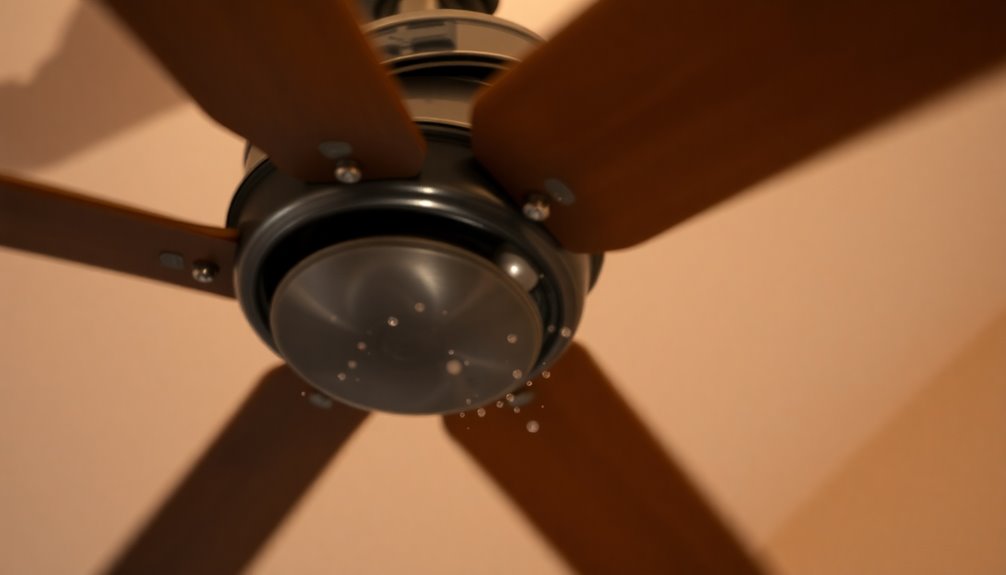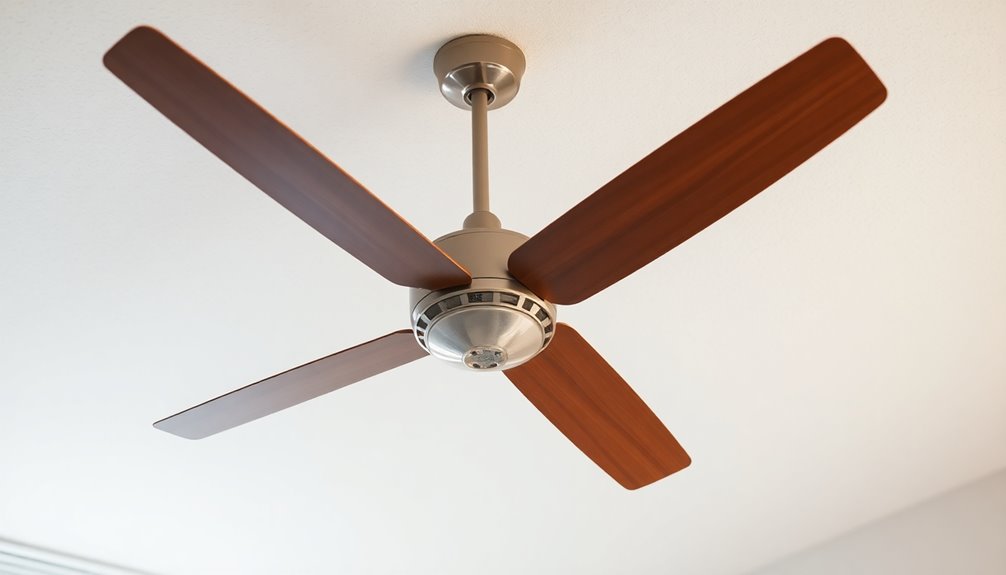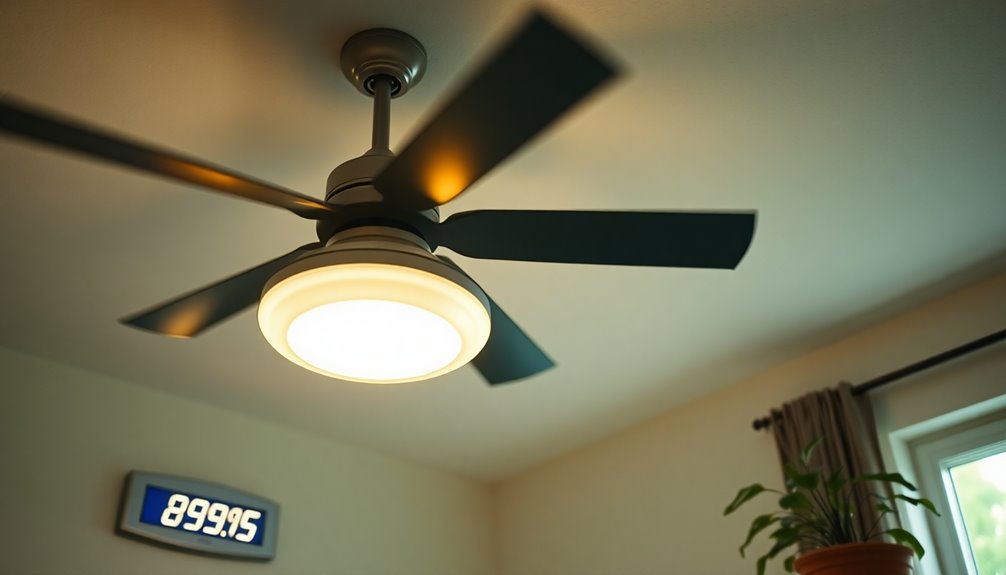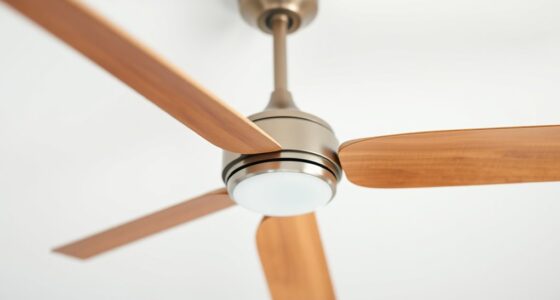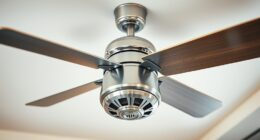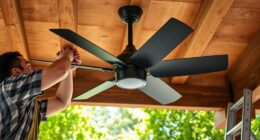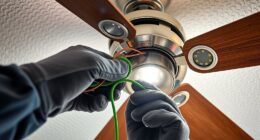If your ceiling fan's making noise, it's likely due to loose screws, unbalanced blades, or motor issues. Loose screws can cause rattling, while unbalanced blades lead to vibrations and noise. Worn motor components might create humming sounds, and dirty bearings can result in grinding noises. You should also inspect for dust buildup or improper installation, which can amplify the sounds. Regular maintenance, like tightening screws and cleaning, keeps your fan operating quietly. Tackling these issues early guarantees a calmer environment—keep exploring to discover more tips on how to keep your ceiling fan silent and efficient!
Key Takeaways
- Loose screws in the fan assembly can cause rattling or clicking noises during operation.
- Unbalanced blades may lead to vibrations, resulting in unwanted noise while the fan is running.
- Worn motor components can produce humming, buzzing, or whirring sounds due to strain or malfunction.
- Dirty bearings create friction, which often leads to grinding or squeaking noises when the fan is in use.
- Dust buildup can disrupt motor function and contribute to overall noise levels in ceiling fans.
Common Causes of Ceiling Fan Noise

When it comes to ceiling fan noise, you might be surprised at how many factors can contribute to the issue. One common culprit is loose screws. If screws aren't tightened properly during installation or have become loose over time, you may hear rattling or clicking sounds as the fan operates.
Another frequent cause of noise is unbalanced blades. When the blades have uneven weight distribution, are damaged, or accumulate dirt, they can create vibrations that result in wobbling and associated noise. This can be an annoyance, distracting you from enjoying your space.
Lastly, motor issues can greatly affect how quietly your fan runs. Worn windings or loose components can lead to humming, buzzing, or whirring sounds that signal electrical or mechanical problems. Additionally, dirty or damaged bearings can increase friction, producing grinding or squeaking noises.
To prevent these issues, proper installation is essential. Misalignment or insecure mounting can result in vibrations and noise, making it necessary to check your fan's installation. By addressing these common causes, you can enjoy a quieter and more comfortable environment. Furthermore, regular maintenance and proper use can help ensure that your ceiling fan operates efficiently and quietly over time.
Diagnosing Noise Issues

To effectively diagnose noise issues in your ceiling fan, start by turning it off and carefully inspecting for loose screws and components. These are common culprits for rattling or clicking sounds.
Here's a quick checklist to help you out:
- Inspect for Loose Components: Check all screws and attachments, especially around the blades and motor housing.
- Listen to Specific Sounds: While the fan is on, pay attention to the noises. Clicking usually means loose blades, while humming might indicate motor strain.
- Test Speed Settings: Run the fan at different speeds; changes in noise can help you figure out if the problem is motor-related or due to an imbalance in the blades.
- Remove Blades and Test: If you suspect the blades, take them off and run the motor. If the noise persists, the issue might be within the motor itself.
Regularly inspecting for dust and wear can also prevent noise build-up.
Fixing Noisy Ceiling Fans

If your ceiling fan is making unwanted noise, it's crucial to identify the common causes and take effective troubleshooting steps.
Start by checking for loose screws, dust buildup, and proper blade alignment.
Regular maintenance can keep your fan running quietly and efficiently, so let's explore what you can do to fix those pesky sounds.
Common Noise Causes
Understanding the common noise causes of ceiling fans can help you identify and fix issues quickly. Here are some typical culprits:
- Loose Screws: Rattling or clicking noises often stem from loose screws. Regularly check and tighten all screws holding the blades, motor, and light fixtures to minimize sounds.
- Unbalanced Blades: If your blades are unbalanced or warped, you might hear humming or buzzing. Inspect the blades for any damage and use a balancing kit to guarantee they're level.
- Dirty or Dry Motor Bearings: Grinding or squeaking noises can be a sign of dirty or dry motor bearings. Routine cleaning and lubrication are essential for smooth operation.
- Electrical Issues: Humming noises might indicate electrical problems, such as faulty capacitors or incompatible dimmers. Investigate these issues immediately to prevent potential hazards.
Effective Troubleshooting Steps
Fixing a noisy ceiling fan requires a systematic approach to identify and resolve the issue effectively. Start by turning off the fan and thoroughly inspecting all screws, bolts, and connections. Loose parts are a common source of noise, so make certain everything is tight and secure.
Next, test the fan at different speed settings to see if the noise changes, which could help you determine if the issue lies with the motor or blade balance.
Once you've checked for loose parts, remove the fan blades and clean them, along with the motor housing. Dust and debris can lead to unwanted operational noises, so this step is essential.
After cleaning, check for proper blade alignment and levelness. Adjust brackets as necessary to guarantee the blades are balanced; unbalanced blades can cause wobbling and noise.
If the noise persists after these basic troubleshooting steps, consult the manufacturer's manual for specific guidance or seek professional assistance. This way, you can restore your ceiling fan to a quiet operation, enhancing your comfort at home.
Maintenance for Quiet Operation
To keep your ceiling fan running smoothly and quietly, regular maintenance is key. By staying on top of a few simple tasks, you can prevent noise issues and guarantee a comfortable environment. Here's what you should do:
- Tighten Loose Screws: Regularly inspect and tighten all screws and bolts on your fan, especially on the blades and motor assembly. This helps prevent rattling sounds caused by loose components.
- Clean the Blades and Motor: Dust and debris can accumulate on the fan blades and motor housing, causing operational sounds. Wipe them down to enhance airflow efficiency.
- Lubricate the Motor Bearings: Insufficient lubrication can lead to increased friction and noise. Use the appropriate lubricant to keep the motor bearings running smoothly, ideally once a year.
- Check Blade Alignment and Balance: Verify your fan blades are properly aligned. Adjusting the blade pitch or using a balancing kit can greatly reduce wobbling and associated noise.
Performing these maintenance tasks can keep your ceiling fan quiet and efficient for years to come!
Maintenance Tips for Quiet Operation

Over time, regular maintenance can greatly enhance your ceiling fan's quiet operation. Start by following these maintenance tips to keep your fan running smoothly.
First, clean fan blades regularly to prevent dust buildup, which can cause noise and inefficiencies. Wipe them down with a damp cloth, making sure to get into the crevices.
Next, inspect all screws and bolts for any loose screws. Tightening these can notably reduce rattling or clicking sounds when the fan is in use.
It's also crucial to lubricate motor bearings annually according to the manufacturer's guidelines; this helps reduce friction and noise.
Additionally, check the alignment and balance of the blades. If they're wobbling, adjust them to confirm they're level, which can eliminate unwanted noise.
Finally, replace any worn-out or damaged parts promptly. This not only maintains peak performance but also prevents further noise issues from developing.
When to Seek Professional Help

Ceiling fan issues can sometimes escalate beyond simple fixes, signaling the need for professional help. If you notice persistent noise despite tightening screws and routine maintenance, it's time to contemplate expert assessment.
Here are some situations where you should definitely seek help:
- Unusual Sounds: If you hear crackling or sizzling noises, address this immediately to avoid potential fire hazards.
- Significant Wobbling: If your fan wobbles or feels unbalanced and you can't fix it with standard adjustments, a professional intervention guarantees safety and proper functioning.
- Motor Problems: If the motor appears to be malfunctioning or if the bearings are worn out beyond simple lubrication, consulting a professional is advisable for replacement and repair.
- Electrical Issues: For complex installation problems or uncertainty about electrical connections, it's best to hire a licensed professional electrician to avoid safety risks.
Don't ignore these signs! Taking action early can prevent further damage and guarantee your ceiling fan operates effectively and safely.
Preventing Future Noise Problems

Keeping your ceiling fan in top shape is key to preventing future noise problems. Start by regularly tightening all screws and components. Loose parts often lead to rattling sounds that can be annoying.
You should also clean the fan blades and motor housing at least every few months to eliminate dust and debris, which can contribute to noise.
Next, don't forget to lubricate the motor bearings annually. This reduces friction and maintains smooth operation, minimizing potential noise.
Regularly inspect the fan blades for proper alignment and balance. Unbalanced blades can cause vibrations that lead to increased noise.
Finally, make sure your fan is installed according to the manufacturer's guidelines. Improper installation can create persistent noise issues that are hard to diagnose.
If you follow these steps, you'll greatly reduce the chances of encountering noise problems with your ceiling fan. Regular maintenance not only enhances the fan's performance but also extends its lifespan, giving you a quieter and more enjoyable environment.
Frequently Asked Questions
How Do I Stop My Ceiling Fan From Making Noise?
To stop your ceiling fan from making noise, start by tightening all screws and components, including blade brackets and light fixtures.
Clean and lubricate the bearings annually to reduce friction.
If the blades are unbalanced, use a blade balancing kit to adjust them.
Check the mounting bracket to verify it's securely fastened.
Finally, regularly inspect the blades and motor for wear or damage to prevent noise issues from escalating.
Is Ceiling Fan Noise Normal?
Isn't it amazing how a ceiling fan can serenade you with its gentle hum?
Yes, some noise is perfectly normal, like a soft whoosh that dances through the air. However, if you hear persistent clattering or ominous buzzing, it might be time to investigate deeper. You don't want your fan to turn into a noisy monster!
Regular maintenance can help keep those sounds soothing instead of startling. Enjoy the breeze, and listen carefully!
Do Ceiling Fans Need to Be Lubricated?
Yes, ceiling fans do need lubrication, especially older models with accessible bearings.
You should check your fan's manual to see if it requires periodic oiling. If it does, using a lightweight machine oil can keep the motor bearings running smoothly.
Regular lubrication helps prevent wear and tear, ensuring your fan operates efficiently.
What Is the Reason for Sound in a Ceiling Fan?
You hear a strange noise from your ceiling fan, and it's unsettling.
The reason for that sound could be a loose screw or an unbalanced blade, causing vibrations.
Maybe it's mechanical issues like misalignment or lack of lubrication, leading to grinding sounds.
Dust buildup might also be at play, increasing friction.
Finally, there could be electrical issues, like a faulty dimmer, creating a persistent hum.
You'll want to investigate!
Conclusion
To sum up, a noisy ceiling fan can disrupt your peace, but understanding its causes and solutions can help you restore tranquility. Remember, "a stitch in time saves nine"—addressing issues early can prevent bigger problems down the road. By diagnosing and fixing the noise, along with regular maintenance, you can enjoy the soothing breeze of a quiet fan. Don't hesitate to seek professional help if needed, ensuring your home remains a comfortable haven.
